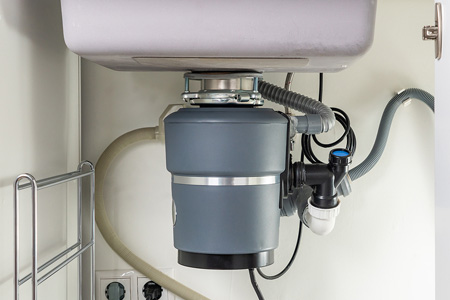An Comprehensive Guide to Fixing a Leaky Garbage Disposal
An Comprehensive Guide to Fixing a Leaky Garbage Disposal
Blog Article
Here down the page you might get additional worthwhile answers all about Why Is .

Waste disposal unit are vital kitchen area home appliances that help in getting rid of food waste effectively. Nevertheless, a leaking waste disposal unit can be an aggravating and messy issue to handle. Thankfully, several leaks can be taken care of conveniently with a couple of easy actions. In this post, we will certainly review just how to take care of a leaking garbage disposal successfully.
Intro
Waste disposal unit are mounted under kitchen area sinks and are designed to shred food waste right into smaller pieces, permitting it to pass through the plumbing system quickly. While these devices are typically dependable, leakages can occur with time as a result of deterioration, loosened connections, or damages to the unit.
Usual Reasons For Leakages in Garbage Disposals
Worn Seals and Gaskets
Seals and gaskets play a critical function in stopping water from leaking out of the garbage disposal. Gradually, these elements can degrade, leading to leakages around the disposal device.
Loose Connections
The connections in between the waste disposal unit and the plumbing system can become loosened over time, creating water to leakage out throughout procedure.
Cracks or Holes in the Disposal System
Physical damage to the garbage disposal, such as fractures or openings in the real estate, can additionally result in leakages.
Recognizing the Resource of the Leak
Before trying to deal with a leaking garbage disposal, it is important to determine the source of the leakage. This can typically be done through aesthetic inspection or by conducting straightforward examinations.
Visual Evaluation
Check the garbage disposal device carefully for any indications of water leak. Pay very close attention to areas around seals, gaskets, and connection points.
Testing for Leaks
One method to check for leaks is by running water through the disposal system and looking for any noticeable signs of leak.
Devices and Products Needed for Dealing With a Leaking Garbage Disposal
Prior to starting the repair work process, collect the essential tools and products, including a screwdriver, flexible wrench, plumbing professional's putty, substitute seals or gaskets, and epoxy or patching material for fixing splits or openings.
Step-by-Step Guide to Taking Care Of a Leaking Waste Disposal Unit
Switch off the Power
Before attempting any repairs, make certain that the power to the waste disposal unit system is switched off to stop the threat of electrical shock.
Situate the Leak
Recognize the precise location of the leakage and establish the cause.
Tighten up Connections
Use a wrench to tighten any loosened connections between the disposal unit and the pipes system.
Replace Seals or Gaskets
If the leakage results from worn seals or gaskets, remove the old elements and replace them with brand-new ones.
Patching Splits or Openings
For splits or openings in the disposal device, use epoxy or an appropriate patching product to secure the damaged area.
Testing the Waste Disposal Unit After Fixing
Once the repair work is full, examine the garbage disposal by running water via it to make certain that the leakage has actually been dealt with.
Preventive Maintenance Tips to Prevent Future Leakages
To stop future leakages, it is essential to do regular maintenance on your waste disposal unit. This includes maintaining it clean, staying clear of putting non-food things or difficult objects down the disposal, and periodically looking for leakages or various other issues.
Final thought
Finally, fixing a dripping waste disposal unit is a relatively uncomplicated process that can be finished with fundamental tools and materials. By adhering to the steps detailed in this short article and practicing preventive upkeep, you can maintain your garbage disposal in good working problem and stay clear of costly repair services in the future.
What to Do About a Leaking Garbage Disposal
A leaking garbage disposal often goes unnoticed until you confront a sopping cabinet, a foul-smelling puddle, or an audible drip-drip-drip from the unit. The fix can be frustrating, too, because the leak can stem from a number of components in the system. Fortunately, with a little sleuthing, you can zero in on the leak and—depending on the exact location—stop the icky oozing and repair the component that caused it. Worst case scenario, if it turns out that the garbage disposal must be replaced, installing a new one is a reasonable do-it-yourself task for those with basic plumbing skills. Read on to keep the cash you’d otherwise hand over to a pro.
Prepare to find the leak
Prior to testing the garbage disposal for leaks, unplug it at the wall outlet and turn off the power from the breaker box to prevent electrical shock. Then insert a watertight sink stopper into your sink drain and wipe the unit dry with a clean cloth. In any handy container, mix a few drops of food coloring into a few cups of water, and pour the dyed water onto the sink stopper to help you locate the leak.
Investigate the source
the top, where the disposal meets the sink drain the side, where the dishwasher hose or main drain pipe connects to the disposal or the bottom of the unit Inspect each of these locations while gliding a light-colored rag over the unit; the dyed water will readily show on the rag and reveal the location of the leak. If a leak isn’t immediately apparent, remove the sink stopper and pour a few more cups of dyed water down the sink drain, then check for leaks again. Leaks near the top of the unit are more likely to show themselves while the sink is plugged, while side and bottom leaks are more noticeable while the sink is unplugged.
The metal sink flange that sits directly inside the sink drain is typically sealed around the top with plumber’s putty (a clay-like sealant) and then secured from under the sink with bolts. If the plumber’s putty deteriorates, or the bolts loosen, the flange can no longer form a watertight seal between the sink drain and the disposal—which could cause a leak at the top of the unit.
To reseal the leaky flange, you must first detach the garbage disposal. Start by loosening the screws securing the main drain pipe to the disposal, then loosen the screws in the metal clamp securing the dishwasher hose to the disposal and detach the drain pipe and dishwasher hose from the disposal. Loosen the screws in the mounting ring that connects the disposal to the metal mounting assembly beneath the sink, then pull down the disposal and carefully set it on a clean, dry surface. Loosen the bolts in the mounting assembly with a wrench, then pull down the mounting assembly and set it near the disposal.

We hope you enjoyed reading our piece on Garbage Disposal Leaking From Bottom. Thanks a lot for spending some time to read through our blog. Do you know someone else who is enthusiastic about the topic? Do not hesitate to promote it. Thanks a lot for your time invested reading it.
Click Here Report this page